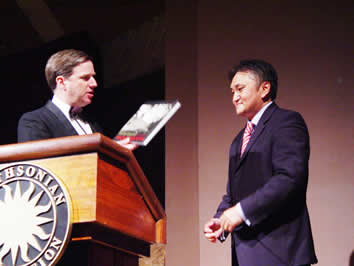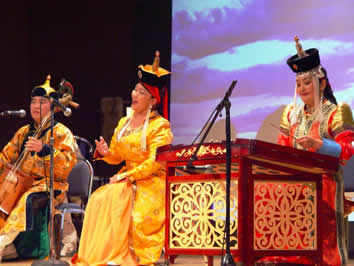Mongolia Celebrates 800th Birthday
By: Alexis Fabbri
 Above: Dr. Cristian
Samper, Natural History Museum Director, presents the
Mongolian Embassy’s Deputy Chief of Mission, Odonjil Banzrageh,
with a gift.
next photo
Above: Dr. Cristian
Samper, Natural History Museum Director, presents the
Mongolian Embassy’s Deputy Chief of Mission, Odonjil Banzrageh,
with a gift.
next photo
 Above: Araaniziin
Bat-Ochir, Batchuluun Sarantuya and Badam Bolormaa perform traditional Mongolian music.
prev photo
Above: Araaniziin
Bat-Ochir, Batchuluun Sarantuya and Badam Bolormaa perform traditional Mongolian music.
prev photo
WASHINGTON -- Mongolia celebrated its 800th birthday with song, dance,
fashion and a lot of drums at the Natural History Museum on October 6. The
even kicked off the Smithsonian’s weekend-long "Festival of Mongolia"
in this capital city, home to the nation’s largest Mongolian community.
Museum
Director Dr. Cristian Samper
welcomed the packed house after a delay when a dancer’s necklace broke, sending
beads all over the backstage area. U.S. Ambassador to Mongolia Mark Minton and
Mongolian embassy’s Deputy Chief of Mission Odonjil Banzrageh,
emphasized the warmth of a people from an often cold country.
A
film shown before the live action started painted a modern picture of ancient Mongolia as a country proud of democratic reforms and
protective of its vast, untouched landscapes. Mongolia is also attempting a public relations campaign to
recast Ghengis Khan–known in Mongolia as Chinggi–as a powerful,
well-respected general.
The
show began with a solo performance by Araaniziin Bat-Ochir on the horse-head fiddle, an elongated violin topped
with a dragon head ornament. He was joined onstage by Badam
Bolormaa and her yoochin
for a moving, multi-movement duet. Bolormaa gently
struck the strings of the yoochin to make harp-like
sounds to accompany the Bat-Ochir’s horse-head
fiddle, while a photo slide show of striking photographs of their home country
ran in the background. Bat-Ochir surprised the
audience when he began to sing in voice that alternated from low and guttural
to an open-mouthed, "how did he do that?" whistle. But
when vocalist Batchuluun Sarantuya
belted out long, vibrating notes, backed by the musicians, it felt like a
theatre in Ulaanbaatar.
Dance of Courtship
In the next act, dancers
representing Burte Chono,
"the grey wolf" and Goo Marai
"the beautiful doe" took the stage, recounting the tale of their
mystical meeting on the banks of the River Onon to
start the nation of the Mongols. The dance of courtship ended when the pair
left the stage, and warriors took over. Banging hide-covered drums and gongs, a
sort of battle of the bands erupted between the leather and armor-clad warriors
as they each sounded off from opposite sides of the stage. The pounding
intensified until finally things were calm again, and the pony-tailed young
warriors bowed to the crowd, beaming with pride.
As
the show changed pace, young Mongolian models–with admirable equilibrium–worked
the stage as if it were a runway in Milan, twirling with great care not to drop the large
headpieces that accompanied each outfit. Traditional and modern Mongolian gowns
lit the room with gold, blue, silver and red. Many pieces were accented with
animal fur and horns, acknowledging the country’s dependence on and love for
wildlife.
Another
part of the show celebrated Shamanism, an ancient religion founded on the
trinity of Eternal Sky, Earth and Mankind practiced by Chinggis.
A dancer representing a shaman, wearing an oversized, bobblehead-like
mask with a smiling old man’s face stole the show. He blessed the crowd from
the stage and then walked among them, nodding and skipping. Three masked
dancers, dressed as the Trinity in skull-spotted, red costumes, shook and
twirled on stage as the Shaman drew grins and giggles, bobbing his oversize
head and twirling his medicine bag and cane. When he removed his mask for the
curtain call, he looked just like a smiling, kindly Chinggis.
Embassy
staff, dignitaries and guests mingled during an after-show reception in the
museum rotunda. They munched on Mongolian snacks like arrul(dried yogurt) and
washed it down, well the brave ones anyway, with a Mongolian liquor bearing the
face of Ghengis Khan–that two Mongolian women said
was best without ice or lime "so you can taste it."
|